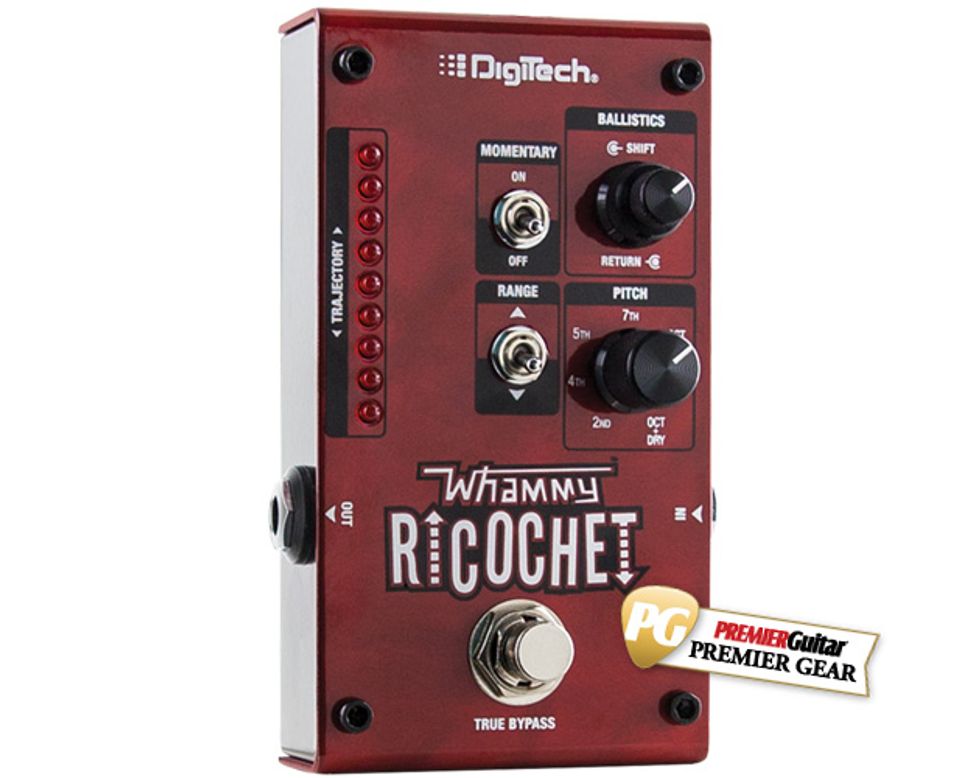When DigiTech unveiled the first Whammy pedal 28 years ago, it was an instant hit. It wasn’t just that a pitch-shifting stompbox was a new and inspiring idea. With its built-in controller pedal, the Whammy was fresh-sounding and expressive, allowing players to vary the rate of their pitch bends, much as if they were playing, well, a whammy bar.
DigiTech recently marked the Whammy’s latest anniversary by removing the effect’s trademark pedal. Okay, not really—the company still makes the excellent fifth-generation Whammy V, the Bass Whammy, and the Whammy DT (which specializes in chordal pitch-shifting for simulated drop-tuning effects), all with built-in treadles. But nixing the expression pedal, as they do here on the Ricochet, makes the Whammy effect accessible to a particular and growing subset of guitarists: those with too many damn stompboxes to accommodate the large-format Whammy on their pedalboards.
A Smaller Shifter
The downscaling works. The Ricochet is roughly the size of a standard B-sized stompbox. It resides in a tough, folded-metal enclosure with quality knobs and a soft-touch relay footswitch. There’s no battery compartment; you must use an adapter with at least 300 mA of juice (not included).
Meanwhile, there’s a clever workaround for the absence of a treadle. A pair of concentric knobs lets you independently set attack and release times for the pitch effect, from instantaneous shifts to excruciatingly slow builds and dive bombs. Another knob specifies the transposition interval. A toggle switch selects between upward and downward bends. A second toggle determines whether notes remain transposed until you press the footswitch again, or only as long as you hold the switch down. The former setting would be handy for, say, playing an entire song in a transposed tuning, while the latter is good for injecting impossibly high or low notes into standard-tuned solos. You can tell at a glance whether you’re set for up or down, thanks to an LED ladder that indicates the current direction.
I found this streamlined system fun and musically useful. Will it satisfy an extant Whammy user? It depends how often and how much you vary the speed of your pedal pushing. Do you work the effect rhythmically, carefully timing notes to arrive at a particular instant? Or, like most players, do you just whack the thing on for instant range expansion? If you’re the latter type, Ricochet will probably cover your basses.
Ratings
Pros:
Compact size. Excellent sound quality. Good price.
Cons:
For maximum timing precision, a treadle still works best.
Tones:
Ease of Use:
Build/Design:
Value:
Street:
$149.95
DigiTech Whammy Ricochet
digitech.com
Transposition Mission
I confess that I haven’t used a DigiTech Whammy in many years—and holy cannoli, has the pitch-shift quality improved! Early versions couldn’t handle chords well, and the transpositions had a bleating, obviously digitized quality. But now the pitch shifting is damn good.
To demonstrate, allow me to walk you through the audio clip that accompanies this article. I start out with phased arpeggios at standard pitch, and then bounce them up an octave while playing the same figure. (Clean-toned shifts in large intervals are the real acid test for pitch-transposition effects.) You can tell it’s a digital effect, yet it’s perfectly listenable. Next comes a distorted example with the same octave shift, but with slower rise and fall times. It certainly sounds like I’m working a pedal, and the shifted power chords retain their chunky goodness.
Another clean-toned example follows at 1:00. Here I noodle over an Am/Gm progression, but I’m actually fingering notes in A minor only, shifting down a whole-step for the G minor bits. Yeah, I can hear a tiny difference in timbre between the dry and pitch-shifted tones, but it’s so close that it hardly matters. And again, dig how cleanly the triads transpose!
Most Ricochet transpositions solo the dry signal, though one setting, OCT + DRY, mixes wet and dry, generating dissonant tension as the two voices rub against each other on their way to an octave transposition. You hear this effect starting at 01:38. The final example, at 02:10, uses the octave-down setting for a pseudo 8-string-bass effect. The other available transpositions are perfect fourths and fifths and minor sevenths. You can use all seven settings in both ascending and descending modes.
The Verdict
Is your beloved Whammy gathering dust just because it won’t fit on your board? Case closed: get a Ricochet. If you’re new to pitch-shift effects but eager to explore, this great sounding, solidly built, and reasonably priced pedal provides a superb introduction.






















